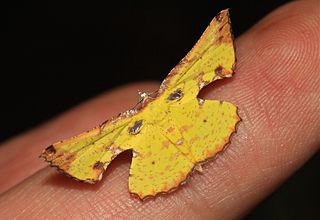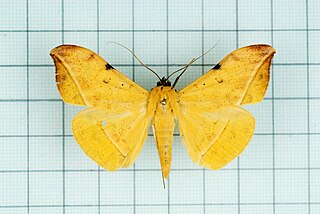
Attacus atlas, the Atlas moth, is a large saturniid moth endemic to the forests of Asia. The species was first described by Carl Linnaeus in his 1758 10th edition of Systema Naturae.

Actias selene, the Indian moon moth or Indian luna moth, is a species of saturniid moth from Asia. It was first described by Jacob Hübner in 1807. This species is popular among amateur entomologists and is often reared from eggs or cocoons that are available from commercial sources. They fly mainly at night.

Gnathothlibus erotus, the white-brow hawkmoth, is a moth of the family Sphingidae. The species was first described by Pieter Cramer in 1777.

Dordura is a monotypic moth genus of the family Noctuidae erected by Frederic Moore in 1882. Its only species, Dordura aliena, was first described by Francis Walker in 1865. It is found in the Indian subregion, Sri Lanka, Myanmar, Thailand, Peninsular Malaysia, Sumatra, Borneo and New Guinea.

Bastilla crameri is a moth of the family Noctuidae first described by Frederic Moore in 1885. It is found from the Indian subregion to Sri Lanka, Peninsular Malaysia, Japan, Sumatra and Borneo. It is also present in South Africa.

Bastilla arctotaenia is a moth of the family Noctuidae. It is found from Japan, Korea and the Indo-Australian tropics throughout to India, Sri Lanka, Myanmar east to New Guinea and Queensland. It has also been recorded in Vanuatu and Fiji.

Argina astrea, the crotalaria podborer, is a moth of the family Erebidae. The species was first described by Dru Drury in 1773. It is found in eastern Africa, southern Asia of India, Sri Lanka, and Indo-Australia, including the Pacific Islands and Australia.

Probithia exclusa is a moth of the family Geometridae. It is found in the north-eastern Himalaya, Sri Lanka, the Philippines, Sulawesi and Sundaland.

Eucyclodes gavissima, the Oriental orange banded green geometer moth, is a species of moth of the family Geometridae described by Francis Walker in 1861. It is found in the Indian subregion, Sri Lanka, Bhutan, western China, Taiwan, Sumatra and Borneo.

Urapteroides astheniata is a moth of the family Uraniidae first described by Achille Guenée in 1857. It is found in south-east Asia, from India, Sri Lanka to Fiji, including New Guinea and the tropical north of Australia.

Hypocala violacea is a species of moth of the family Erebidae first described by Arthur Gardiner Butler in 1879. It is found in the Indo-Australian tropics of India, Sri Lanka, and Myanmar.

Condica dolorosa is a moth of the family Noctuidae. It is found in the Indo-Australian tropics, including Borneo, Hawaii, Hong Kong, India, Sri Lanka, Taiwan and Queensland in Australia.

Anticarsia irrorata, the owl moth, is a species of moth in the family Noctuidae. It is native to the Old World tropics.

Serrodes campana is a species of moth of the family Erebidae first described by Achille Guenée in 1852. It is found from the Indo-Australian tropics to eastern Australia, Fiji, Samoa and New Caledonia. It is also present in Japan, Korea and Sri Lanka. The adult is a fruit piercer, but also feeds on flower nectar.

Corymica pryeri is a species of moth of the family Geometridae first described by Arthur Gardiner Butler in 1878. It is found in Japan, Taiwan, the north-eastern Himalayas, Sumatra, Borneo, New Guinea and possibly Queensland, Australia.

Hamodes propitia is a moth in the family Erebidae first described by Félix Édouard Guérin-Méneville in 1831. It is found in the north-eastern Himalayas, Myanmar, Thailand, Borneo, Sumatra, from the Philippines east to Queensland, the Carolines (Palau) and the Solomon Islands.

Gymnoscelis tristrigosa is a moth in the family Geometridae. It was described by Arthur Gardiner Butler in 1880. It is found from Sri Lanka and Taiwan to Fiji, Tonga and New Caledonia.
Sauris hirudinata is a moth of the family Geometridae. It was described by Achille Guenée in 1858. It is found in Fiji, Sri Lanka, India, Hong Kong, as well as on Peninsular Malaysia and Borneo.
Ugia signifera is a species of moth in the family Erebidae. It is found in Indonesia (Sumatra) and on Borneo and Peninsular Malaysia. The species is found in various lowland habitats, ranging from forested areas to disturbed areas and coastal vegetation.
Pompelon is a monotypic moth genus in the family Zygaenidae erected by Francis Walker in 1854. Its only species, Pompelon marginata, was first described by Félix Édouard Guérin-Méneville in 1843. It is a day-flying moth found throughout Southeast Asia, with sightings in the Philippines, Myanmar, Thailand, Sulawesi, Borneo, Peninsular Malaysia, and Sumatra.
















